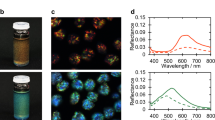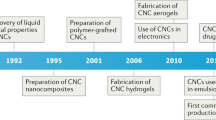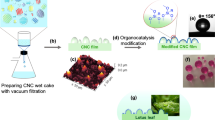Abstract
Cellulose nanocrystals are renewable plant-based colloidal particles capable of forming photonic films by solvent-evaporation-driven self-assembly. So far, the cellulose nanocrystal self-assembly process has been studied only at a small scale, neglecting the limitations and challenges posed by the continuous deposition processes that are required to exploit this sustainable material in an industrial context. Here, we addressed these limitations by using roll-to-roll deposition to produce large-area photonic films, which required optimization of the formulation of the cellulose nanocrystal suspension and the deposition and drying conditions. Furthermore, we showed how metre-long structurally coloured films can be processed into effect pigments and glitters that are dispersible, even in water-based formulations. These promising effect pigments are an industrially relevant cellulose-based alternative to current products that are either micro-polluting (for example, non-biodegradable microplastic glitters) or based on carcinogenic, unsustainable or unethically sourced compounds (for example, titania or mica).
This is a preview of subscription content, access via your institution
Access options
Access Nature and 54 other Nature Portfolio journals
Get Nature+, our best-value online-access subscription
$29.99 / 30 days
cancel any time
Subscribe to this journal
Receive 12 print issues and online access
$259.00 per year
only $21.58 per issue
Buy this article
- Purchase on Springer Link
- Instant access to full article PDF
Prices may be subject to local taxes which are calculated during checkout





Similar content being viewed by others
Data availability
Additional data relating to this publication are available from the University of Cambridge data repository (https://doi.org/10.17863/CAM.64239).
References
Green, D. S., Jefferson, M., Boots, B. & Stone, L. All that glitters is litter? Ecological impacts of conventional versus biodegradable glitter in a freshwater habitat. J. Hazard. Mater. 402, 124070 (2021).
Pfaff, G. & Reynders, P. Angle-dependent optical effects deriving from submicron structures of films and pigments. Chem. Rev. 99, 1963–1981 (1999).
European Commission. Environmental and Health Risks of Microplastic Pollution (European Union Publications, 2019). https://doi.org/10.2777/54199
ten Kate, A., Schipper, I., Kiezebrink, V. & Remmers, M. Beauty and a Beast: Child Labour in India for Sparkling Cars and Cosmetics (Centre for Research on Multinational Corporations, 2016).
Proposal for Harmonised Classification and Labelling: Titanium Dioxide CLH Report (French Agency for Food, Environmental and Occupational Health & Safety, 2008).
Younes, M. et al. Safety assessment of titanium dioxide (E171) as a food additive. Eur. Food Saf. Auth. J. 19, e06585 (2021).
Frka-Petesic, B. & Vignolini, S. So much more than paper. Nat. Photon. 13, 365–367 (2019).
Klockars, K. W. et al. Asymmetrical coffee rings from cellulose nanocrystals and prospects in art and design. Cellulose 26, 491–506 (2019).
Lagerwall, J. P. F. et al. Cellulose nanocrystal-based materials: from liquid crystal self-assembly and glass formation to multifunctional thin films. NPG Asia Mater. 6, e80 (2014).
Zhang, Y. P., Chodavarapu, V. P., Kirk, A. G. & Andrews, M. P. Nanocrystalline cellulose for covert optical encryption. J. Nanophoton. 6, 063516 (2012).
Zhao, T. H. et al. Printing of responsive photonic cellulose nanocrystal microfilm arrays. Adv. Funct. Mater. 29, 1804531 (2019).
Giese, M., Blusch, L. K., Khan, M. K., Hamad, W. Y. & Maclachlan, M. J. Responsive mesoporous photonic cellulose films by supramolecular cotemplating. Angew. Chem. Int. Ed. 53, 8880–8884 (2014).
Reid, M. S., Villalobos, M. & Cranston, E. D. Benchmarking cellulose nanocrystals: from the laboratory to industrial production. Langmuir 33, 1583–1598 (2017).
Reiner, R. S. & Rudie, A. W. in Production and Applications of Cellulose Nanomaterials (eds Postek, M. T. et al.) 21–24 (TAPPI Press, 2013).
Vanderfleet, O. M. & Cranston, E. D. Production routes to tailor the performance of cellulose nanocrystals. Nat. Rev. Mater. 6, 124–144 (2021).
Chowdhury, R. A., Clarkson, C. & Youngblood, J. Continuous roll-to-roll fabrication of transparent cellulose nanocrystal (CNC) coatings with controlled anisotropy. Cellulose 25, 1769–1781 (2018).
Koppolu, R. et al. Continuous roll-to-roll coating of cellulose nanocrystals onto paperboard. Cellulose 25, 6055–6069 (2018).
Parker, R. M. et al. Hierarchical self-assembly of cellulose nanocrystals in a confined geometry. ACS Nano 10, 8443–8449 (2016).
Gray, D. G. Recent advances in chiral nematic structure and iridescent color of cellulose nanocrystal films. Nanomaterials 6, 213 (2016).
Revol, J.-F., Godbout, L. & Gray, D. G. Solid self-assembled films of cellulose with chiral nematic order and optically variable properties. J. Pulp Pap. Sci. 24, 146–149 (1998).
Gicquel, E., Bras, J., Rey, C. & Jean, B. Impact of sonication on the rheological and colloidal properties of highly concentrated cellulose nanocrystal suspensions. Cellulose 7, 7619–7634 (2019).
Shafiei-Sabet, S., Hamad, W. Y. & Hatzikiriakos, S. G. Rheology of nanocrystalline cellulose aqueous suspensions. Langmuir 28, 17124–17133 (2012).
Haywood, A. D. & Davis, V. A. Effects of liquid crystalline and shear alignment on the optical properties of cellulose nanocrystal films. Cellulose 24, 705–716 (2017).
Diaz, J. A., Wu, X., Martini, A., Youngblood, J. P. & Moon, R. J. Thermal expansion of self-organized and shear-oriented cellulose nanocrystal films. Biomacromolecules 14, 2900–2908 (2013).
Parker, R. M. et al. The self-assembly of cellulose nanocrystals: hierarchical design of visual appearance. Adv. Mater. 30, 1704477 (2018).
Zhu, B. et al. Hyperspectral imaging of photonic cellulose and implications for self-assembly pathways. ACS Nano 14, 15361–15373 (2020).
Berreman, D. W. Optics in stratified and anisotropic media: 4×4-matrix formulation. J. Opt. Soc. Am. 62, 502–510 (1972).
de Vries, H. Rotatory power and other optical properties of certain liquid crystals. Acta Crystallogr. 4, 219–226 (1951).
Beck, S., Bouchard, J. & Berry, R. Controlling the reflection wavelength of iridescent solid films of nanocrystalline cellulose. Biomacromolecules 12, 167–172 (2011).
Dong, X. M., Revol, J.-F. & Gray, D. G. Effect of microcrystallite preparation conditions on the formation of colloid crystals of cellulose. Cellulose 5, 19–32 (1998).
Foster, E. J. et al. Current characterization methods for cellulose nanomaterials. Chem. Soc. Rev. 47, 2609–2679 (2018).
Walters, C. M., Boott, C. E., Nguyen, T. D., Hamad, W. Y. & Maclachlan, M. J. Iridescent cellulose nanocrystal films modified with hydroxypropyl cellulose. Biomacromolecules 21, 1295–1302 (2020).
Bardet, R., Roussel, F., Coindeau, S., Belgacem, N. & Bras, J. Engineered pigments based on iridescent cellulose nanocrystal films. Carbohydr. Polym. 122, 367–375 (2015).
Wang, P. X., Hamad, W. Y. & MacLachlan, M. J. Structure and transformation of tactoids in cellulose nanocrystal suspensions. Nat. Commun. 7, 11515 (2016).
Beck, S. & Bouchard, J. Auto-catalyzed acidic desulfation of cellulose nanocrystals. Nord. Pulp Pap. Res. J. 29, 6–14 (2014).
Lin, N. & Dufresne, A. Surface chemistry, morphological analysis and properties of cellulose nanocrystals with gradiented sulfation degrees. Nanoscale 6, 5384–5393 (2014).
Dong, X. M. & Gray, D. G. Effect of counterions on ordered phase formation in suspensions of charged rodlike cellulose crystallites. Langmuir 13, 2404–2409 (1997).
Chauve, G., Mauran, D., Fraschini, C. & Bouchard, J. Critical discussion on the thermal behavior of sulfated cellulose nanocrystals. TAPPI J. 15, 383–391 (2016).
D’Acierno, F., Hamad, W. Y., Michal, C. A. & Maclachlan, M. J. Thermal degradation of cellulose filaments and nanocrystals. Biomacromolecules 21, 3374–3386 (2020).
D’Acierno, F., Ohashi, R., Hamad, W. Y., Michal, C. A. & MacLachlan, M. J. Thermal annealing of iridescent cellulose nanocrystal films. Carbohydr. Polym. 272, 118468 (2021).
Gençer, A., Van Rie, J., Lombardo, S., Kang, K. & Thielemans, W. Effect of gelation on the colloidal deposition of cellulose nanocrystal films. Biomacromolecules 19, 3233–3243 (2018).
Mu, X. & Gray, D. G. Droplets of cellulose nanocrystal suspensions on drying give iridescent 3-D “coffee-stain” rings. Cellulose 22, 1103–1107 (2015).
Dufresne, A. Nanocellulose: from Nature to High Performance Tailored Materials (De Gruyter, 2012). https://doi.org/10.1515/9783110254600
Frka-Petesic, B., Kamita, G., Guidetti, G. & Vignolini, S. Angular optical response of cellulose nanocrystal films explained by the distortion of the arrested suspension upon drying. Phys. Rev. Mater. 3, 045601 (2019).
Klockars, K. W. et al. Effect of anisotropy of cellulose nanocrystal suspensions on stratification, domain structure formation and structural colors. Biomacromolecules 19, 2931–2943 (2018).
Honorato-Rios, C. et al. Fractionation of cellulose nanocrystals: enhancing liquid crystal ordering without promoting gelation. NPG Asia Mater. 10, 455–465 (2018).
Tardy, B. L. et al. Tessellation of chiral-nematic cellulose nanocrystal films by microtemplating. Adv. Funct. Mater. 29, 1808518 (2019).
Kamita, G. et al. Biocompatible and sustainable optical strain sensors for large-area applications. Adv. Opt. Mater. 4, 1950–1954 (2016).
Acknowledgements
This work was supported by the Engineering and Physical Sciences Research Council (EP/R511675/1 for S.V.; EP/N016920/1 for H.-L.L, J.J.B., M.D.V. and S.V.), by the European Union’s Horizon 2020 Marie Skłodowska-Curie research and innovation programme (H2020-MSCA-ITN-2016 722842 for B.E.D and S.V.) and the European Research Council (ERC-2014-STG H2020 639088 for B.F.-P., R.M.P. and S.V.; ERC-2017-POC 790518 for S.V.). We thank F. Firth for performing the thermogravimetric analysis characterization.
Author information
Authors and Affiliations
Contributions
The concept of R2R-manufactured photonics was conceived by J.J.B., M.D.V. and S.V.; CNC suspensions, films and particles were prepared and characterized by B.E.D.; R2R experiments were realized by B.E.D. and H.-L.L.; B.F.-P and R.M.P. provided critical feedback on results. The manuscript was written by B.E.D., R.M.P., B.F.-P. and S.V. with input from all authors.
Corresponding author
Ethics declarations
Competing interests
The authors declare no competing interests.
Additional information
Peer review information Nature Materials thanks Jay Guo and the other, anonymous, reviewer(s) for their contribution to the peer review of this work.
Publisher’s note Springer Nature remains neutral with regard to jurisdictional claims in published maps and institutional affiliations.
Supplementary information
Supplementary Information
Supplementary Figs. 1–24 and Tables 1 and 2.
Supplementary Video 1
This time-lapse video shows a CNC film drying on a thin R2R web (75 µm), where the stress-induced web warping is clearly visible.
Supplementary Video 2
This time-lapse video shows a CNC film drying on a thick R2R web (500 + 75 µm), where no stress-induced web warping occurs.
Supplementary Video 3
This video shows the drying of a R2R-coated CNC suspension into a structurally coloured film, with the help of a hot air dryer placed in-line and blowing hot air at ~60 °C. The continuous deposition is performed stepwise, with the web being moved every 15 min by ~20 cm at a speed of vc = 0.1 m min–1.
Supplementary Video 4
This time-lapse video shows the in-line peeling of a thick CNC film.
Supplementary Video 5
This video shows a CNC particle initially observed in air being placed in a 1:1 mixture of ethanol and water. The redshift is progressive as ethanol preferentially evaporates and moisture condensation occurs. When no solvent is left, the particle dries and returns to its original colour in air. The video was accelerated six times compared to the original.
Supplementary Video 6
This video shows the samples of Fig. 1j in motion after turning the vials upside-down.
Rights and permissions
About this article
Cite this article
Droguet, B.E., Liang, HL., Frka-Petesic, B. et al. Large-scale fabrication of structurally coloured cellulose nanocrystal films and effect pigments. Nat. Mater. 21, 352–358 (2022). https://doi.org/10.1038/s41563-021-01135-8
Received:
Accepted:
Published:
Issue Date:
DOI: https://doi.org/10.1038/s41563-021-01135-8
This article is cited by
-
Scalable production of structurally colored composite films by shearing supramolecular composites of polymers and colloids
Nature Communications (2024)
-
Inkjet-printed optical interference filters
Nature Communications (2024)
-
Plasmonic metasurfaces of cellulose nanocrystal matrices with quadrants of aligned gold nanorods for photothermal anti-icing
Nature Communications (2023)
-
Photonic crystals with rainbow colors by centrifugation-assisted assembly of colloidal lignin nanoparticles
Nature Communications (2023)
-
Uniaxial orientation of cellulose nanocrystals by zone-casting technique
Cellulose (2023)



